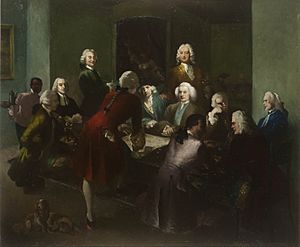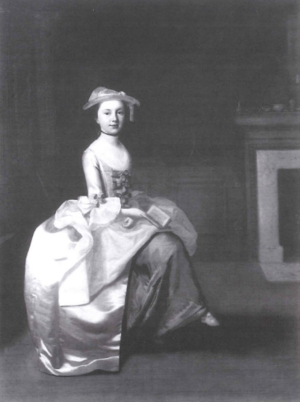George Lewis Scott facts for kids
Quick facts for kids
George Lewis Scott, FRS
|
|
|---|---|

Royal Society Meeting; Scott was made a member in 1737
|
|
| Born | 1 May 1708 Hanover |
| Died | 7 December 1780 (aged 72) London, England |
| Occupation | Mathematician, musician |
| Language | English |
| Nationality | Scottish |
| Alma mater | Leiden University |
| Spouse | Sarah Scott 1751-1752 (separated) |
George Lewis Scott (1708–1780) was a talented math expert and writer. He was a teacher for the future George III from 1751 to 1755. George Scott was friends with many important people of his time. These included the historian Edward Gibbon and the poet James Thomson. People said he was one of the best amateur mathematicians ever. He was very skilled, even though he didn't publish much of his work.
He was briefly married to the writer Sarah Scott. However, they separated after less than a year. His younger brother, Caroline Frederick Scott, was an army officer.
Contents
Early Life and Education

George Lewis Scott was born in Hanover in 1708. He was the oldest of three sons. His father, James Scott, was a close friend of George I of Great Britain. His father worked as a diplomat in different German courts. This was a very important job, especially during the Great Northern War.
His younger brother, Caroline Frederick, was named after Caroline of Ansbach. She was the wife of George II of Great Britain. When their father died in 1726, their mother moved. She took them to the Dutch Republic (now the Netherlands). This was so her children could study at Leiden University. George also studied law in London at Middle Temple. But he didn't often work as a lawyer.
In June 1751, George married the writer Sarah Robinson. She later became known as Sarah Scott. They separated in April 1752. George agreed to pay her £100 each year. The reasons for their separation are not clear.
Career as a Scholar and Tutor

Middle Temple was one of four important law schools in London. George Scott made many friends there. These friends included Ephraim Chambers, who created an encyclopedia. Another friend was Thomas Robinson, who was Sarah's brother.
George started his writing career in London. He joined a group of Scottish writers and publishers. This group included the poet James Thomson and publisher Andrew Millar. They were all part of a group called the Society for the Encouragement of Learning. This society was started in London in 1735. George became a member of the Society of Antiquaries in 1736. He also joined the Royal Society in 1737.
It is thought that he studied with a French mathematician named Abraham De Moivre. De Moivre lived in London for many years. George Scott was seen as an expert in mathematics. This is why he was asked to join the Board of Longitude in the 1760s. He was also related to William Trail, a math professor. They often wrote letters to each other.
Sometimes, Scott helped Viscount Bolingbroke with his writings. Bolingbroke was a former politician. In 1750, Bolingbroke suggested Scott to Frederick, Prince of Wales. He thought Scott would be a good tutor for Frederick's son. This son would later become George III. The chance for a steady income allowed Scott to marry Sarah Robinson. They rented a house in Leicester Square, London.
When Prince Frederick died in 1751, his son became the new Prince of Wales. Thomas Hayter, a bishop, was made the main tutor. Hayter had different political views than Scott. Scott was seen as having views closer to the Jacobites. His cousin, James Steuart, had been sent away from the country. This was because of his part in the Jacobite rising of 1745. A paper was shared that suggested George was surrounded by Jacobites. This caused big political arguments among the Prince's teachers.
In April 1752, Sarah was asked to leave the family home. Her father and brothers were involved. The reasons were not publicly shared. Scott agreed to pay her a yearly payment of £100. They never officially divorced.
Later Achievements and Friendships
When Ephraim Chambers died in 1740, he left notes for a new part of his Dictionary of Arts and Sciences. George Scott was asked to get these notes ready for publishing. The two new books came out in 1753. Scott reportedly received £1,500 for his work.
Even though he was no longer George's tutor in 1755, he got new important jobs. He became a commissioner of HM Excise in 1758. He also served on the Board of Longitude. These jobs showed how respected he was as a mathematician.
In 1767, Edward Gibbon and Jacques Georges Deyverdun asked Scott for a paper. They wanted him to write about the state of science and math in England. This paper was for their book, Mémoires Littéraires de la Grande-Bretagne. In 1775, Gibbon sent Scott parts of his famous book, Decline and Fall of the Roman Empire. He wanted Scott's thoughts and comments.
George Scott was part of London's smart and artistic community. He often appears in letters from his friends. He was known as an excellent musician. He helped Johann Christoph Pepusch with a paper about ancient Greek music for the Royal Society. George Rose, a government official, praised him. He called Scott "amiable, honorable, temperate, and one of the sweetest dispositions I ever knew." Writer Fanny Burney said he was "tall and big" and "very sociable and facetious."
He was a close friend of Samuel Johnson and Lord Auchinleck. Lord Auchinleck was the father of the writer James Boswell. Boswell wrote that Scott was "very kind and polite to me." One of his most important connections was with the political thinker Thomas Paine. Paine mentioned Scott in 1779. Paine's ideas about King George III were supposedly influenced by talks with Scott. Scott also introduced Paine to Benjamin Franklin. This meeting had a big impact on the United States and Europe.
George Lewis Scott passed away in London on December 7, 1780.
Images for kids







